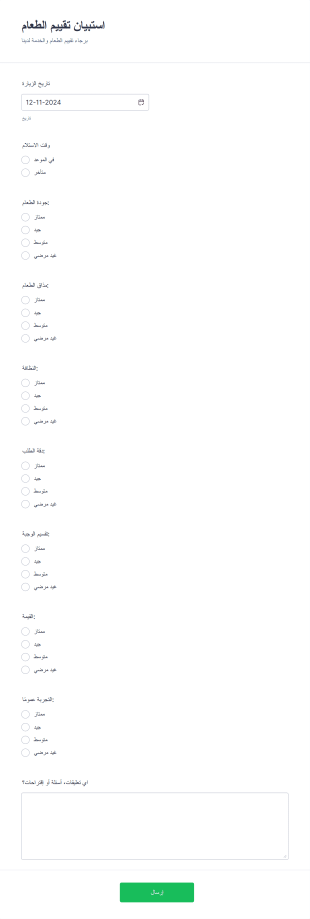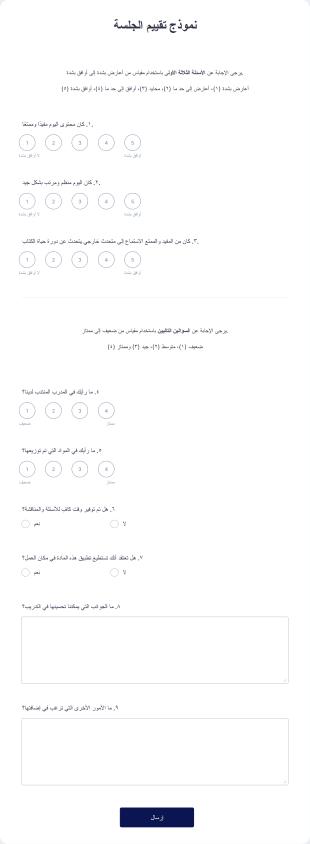استبيانات الملاحظات
حول استبيانات الملاحظات
استطلاعات الرأي هي أدوات منظمة مصممة لجمع الآراء والرؤى والتقييمات من الأفراد حول منتج أو خدمة أو فعالية أو تجربة. تستخدم المؤسسات والشركات والمعلمون ومنظمو الفعاليات استطلاعات الرأي لقياس مستوى الرضا، وتحديد مجالات التحسين، واتخاذ قرارات قائمة على البيانات. يمكن تخصيص هذه الاستطلاعات لمجموعة متنوعة من السيناريوهات مثل ملاحظات ما بعد الشراء، ومشاركة الموظفين، وتقييمات الدورات، وتقييم خدمة العملاء، ومتابعة الفعاليات. من خلال جمع مدخلات مباشرة من أصحاب المصلحة، تساعد استطلاعات الرأي المؤسسات على فهم ما يعمل بشكل جيد وما يحتاج إلى تغيير.
باستخدام Jotform، تصبح عملية إنشاء وإدارة استطلاعات الرأي سهلة وسلسة. يتيح مُنشئ النماذج بالسحب والإفلات من Jotform للمستخدمين تصميم استطلاعات مخصصة دون الحاجة إلى معرفة بالبرمجة. يمكن للمستخدمين الاختيار من بين آلاف القوالب الجاهزة أو إنشاء نماذجهم من البداية، مع إضافة الحقول، والعناصر، والتكاملات حسب الحاجة. يتم تنظيم الردود تلقائيًا في Jotform Tables، مما يسهل تحليل الإجابات ومشاركتها مع أعضاء الفريق. سواء كنت تجمع ملاحظات من العملاء أو الموظفين أو الحضور في فعالية، يبسط Jotform العملية بأكملها، ويساعدك على تحويل الرؤى القيمة إلى تحسينات قابلة للتنفيذ.
استخدامات استطلاعات الرأي
استطلاعات الرأي أدوات متعددة الاستخدامات يمكن تكييفها لتناسب مجموعة واسعة من السيناريوهات، ولكل منها أهداف ومتطلبات فريدة. إليك كيف يمكن استخدامها، ومن يمكنه الاستفادة منها، وكيف يمكن أن يختلف محتواها.
1. حالات الاستخدام الممكنة:
- استبيانات رضا العملاء بعد الشراء أو تقديم الخدمة.
- استطلاعات مشاركة الموظفين أو الخروج من العمل داخل المؤسسات
- نماذج ملاحظات الفعاليات للمشاركين أو المتحدثين أو الرعاة
- استطلاعات تقييم الدورات أو التدريبات للطلاب أو المشاركين
- استطلاعات تقييم المنتج لمختبري النسخ التجريبية أو المستخدمين النهائيين
- استطلاعات قابلية استخدام المواقع أو التطبيقات للمنتجات الرقمية
2. نقاط حل المشكلات:
- تحديد نقاط القوة والضعف في المنتجات أو الخدمات أو التجارب
- كشف الاتجاهات في رضا أو عدم رضا المستخدمين
- جمع اقتراحات التحسين مباشرة من أصحاب المصلحة
- قياس فاعلية التغييرات أو المبادرات الأخيرة
- دعم اتخاذ القرارات المستندة إلى البيانات وتحقيق التحسين المستمر
3. المالكون والمستخدمون المحتملون:
- أصحاب الأعمال، ومديرو خدمة العملاء، وفرق التسويق
- متخصصو الموارد البشرية والقادة الإداريون
- منظمو الفعاليات والمنسقون
- المعلمون، والمدربون، ومسؤولو الدورات التدريبية
- مدراء المنتجات ومصممو تجربة المستخدم/واجهة المستخدم
4. الاختلافات في طرق الإنشاء:
- يختلف المحتوى والحقول حسب حالة الاستخدام: فقد تركز استطلاعات العملاء على الرضا واحتمالية التوصية، بينما قد تشمل استطلاعات الموظفين أسئلة عن ثقافة العمل والإدارة.
- غالبًا ما تتضمن نماذج تقييم الفعاليات مقاييس تقييم للوجستيات، والمتحدثين، والتجربة العامة.
- قد تستخدم استطلاعات تقييم المنتج أسئلة مفتوحة لاقتراحات الميزات أو الإبلاغ عن الأعطال.
- بعض الاستطلاعات تتطلب الخصوصية، بينما قد تجمع أخرى معلومات التواصل للمتابعة.
في الخلاصة، تعد استبيانات الملاحظات أدوات قابلة للتكيف تخدم مجموعة واسعة من الاحتياجات، مع إمكانية تخصيص هيكلها ومحتواها بما يتوافق مع أهداف كل حالة وجمهورها المستهدف.
كيفية إنشاء استطلاع رأي
إنشاء استبيان ملاحظات فعال باستخدام Jotform هو عملية بسيطة يمكن تخصيصها لأي سيناريو، سواء كنت تبحث عن آراء العملاء، أو رؤى الموظفين، أو تقييمات الفعاليات. إليك دليلًا خطوة بخطوة لمساعدتك في تصميم وتوزيع وإدارة استبيان الملاحظات لتحقيق أقصى تأثير:
1.تحديد هدفك:
- حدد بوضوح ما الذي تريد معرفته من الاستطلاع. هل تقيس رضا العملاء، أو تجمع ملاحظات الموظفين، أو تقيم فعالية؟ سيوجه هدفك نوعية الأسئلة التي تضيفها.
2. اختر نقطة البداية:
- سجّل الدخول إلى حساب Jotform الخاص بك وانقر على “إنشاء” في صفحة مساحة العمل الخاصة بك.
- اختر "نموذج"، ثم قرر ما إذا كنت ستبدأ من الصفر أو تستخدم أحد أكثر من 10,000 قالب جاهز لاستطلاعات الرأي من Jotform. يمكن أن توفر القوالب الوقت وتلهمك بأنواع الأسئلة وتخطيط النموذج.
3.اختيار تخطيط النموذج:
- اختر بين النموذج الكلاسيكي (جميع الأسئلة في صفحة واحدة) أو نموذج البطاقات (سؤال واحد في كل صفحة). تعد نماذج البطاقات مثالية للاستطلاعات الطويلة أو عندما تريد توجيه المجيب خطوة بخطوة.
4.إضافة عناصر النموذج وتخصيصها:
- استخدم منشئ النماذج بالسحب والإفلات لإضافة حقول مثل الاختيارات المتعددة، ومقاييس التقييم، ومقاييس ليكرت، وصناديق النص المفتوحة، والقوائم المنسدلة.
- لاستطلاعات العملاء، أدرج أسئلة حول مستوى الرضا، وجودة المنتج، واحتمالية التوصية به.
- لاستطلاعات الموظفين، أضف أسئلة حول بيئة العمل، والإدارة، والتطوير المهني.
- لاستطلاعات تقييم الفعاليات، أضف تقييمات لتنظيم الحدث، والمحتوى، واللوجستيات، بالإضافة إلى أسئلة مفتوحة للاقتراحات.
- استخدم عناصر واجهة المستخدم Widgets للميزات المتقدمة مثل تقييم النجوم، وأشرطة التمرير، أو رفع الملفات للحصول على ملاحظات أكثر تفصيلاً.
5. إضفاء الطابع الشخصي على التصميم:
- انقر على أيقونة بكرة الطلاء للوصول إلى مصمم النماذج.
- اضبط الألوان، والخطوط، والسمات لتتناسب مع علامتك التجارية أو فعاليتك.
- أضف شعار مؤسستك لإضفاء لمسة احترافية.
٦. إعداد الإشعارات والخصوصية:
- في قائمة الإعدادات، قم بتكوين تنبيهات البريد الإلكتروني لتنبيهك بالرسائل المرسلة الجديدة.
- قم بإعداد رسائل البريد الإلكتروني للرد التلقائي لشكر المشاركين على ملاحظاتهم.
- إذا كانت السرية مهمة، تأكد من أن الحقول التعريفية اختيارية أو محذوفة.
7. نشر الاستبيان ومشاركته:
- انقر على “نشر” لإنشاء رابط قابل للمشاركة.
- قم بتوزيع استبيانك عبر البريد الإلكتروني، أو وسائل التواصل الاجتماعي، أو قم بتضمينه على موقعك الإلكتروني.
- بالنسبة للاستطلاعات الداخلية، قيد الوصول على مستخدمين أو فرق محددة.
8. الاختبار والإطلاق:
- استخدم ميزة المعاينة لاختبار الاستبيان الخاص بك والتأكد من أن جميع المنطق والحقول تعمل على النحو المنشود.
- قدم استجابة اختبارية وتحقق من أن البيانات تجمع بشكل صحيح في Jotform Tables.
تحليل التقييمات واتخاذ الإجراءات بناءً عليها:
- راجع الردود في Jotform Tables، باستخدام الفلاتر والبحث لتحديد الاتجاهات.
- صدر البيانات لتحليل إضافي أو شارك النتائج مع أصحاب المصلحة.
- استخدم الرؤى لتنفيذ التحسينات وإغلاق دائرة الملاحظات.
من خلال اتباع هذه الخطوات، يمكنك إنشاء استطلاع رأي مصمم خصيصًا لجمهورك، سهل الإكمال، ويوفر رؤى قابلة للتنفيذ لمؤسستك.
الأسئلة الشائعة
1.ما هو استطلاع الرأي؟
استطلاع الرأي هو استبيان منظم مصمم لجمع الآراء والتقييمات والاقتراحات من الأفراد حول منتج أو خدمة أو فعالية أو تجربة معينة.
2.لماذا تعد استطلاعات الرأي مهمة للمؤسسات؟
تساعد استطلاعات الرأي المؤسسات على فهم رضا العملاء أو الموظفين، وتحديد مجالات التحسين، واتخاذ قرارات مستنيرة بناءً على مدخلات حقيقية.
3.ما المعلومات التي يجب تضمينها في استطلاع الرأي؟
يتضمن استطلاع الرأي عادةً أسئلة حول مستوى الرضا، والتجارب المحددة، والاقتراحات للتحسين، وأحيانًا معلومات ديموغرافية لتقسيم الردود.
4.هل توجد أنواع مختلفة من استطلاعات الرأي؟
نعم، يمكن تخصيص استطلاعات الرأي لأغراض متعددة مثل رضا العملاء، ومشاركة الموظفين، وتقييم الفعاليات، وتقييم المنتجات، والمزيد.
5.من الذي يجب أن يستخدم استطلاعات الرأي؟
يمكن لأصحاب الأعمال، والمتخصصين في الموارد البشرية، والمعلمين، ومنظمي الفعاليات، ومديري المنتجات الاستفادة جميعًا من استطلاعات الرأي لجمع الرؤى من جماهيرهم.
6.كيف تضمن استطلاعات الرأي خصوصية المجيبين؟
يمكن تصميم الاستطلاعات لتكون مجهولة من خلال حذف الحقول التعريفية، ويمكن تخزين البيانات بشكل آمن والوصول إليها فقط من قبل الأشخاص المصرح لهم.
7.ما هي أفضل الممارسات لتصميم استطلاعات رأي فعالة؟
اجعل الاستطلاعات موجزة، واستخدم مزيجًا من أنواع الأسئلة، واحرص على وضوح الصياغة، ووفر خيارًا للأسئلة المفتوحة للحصول على رؤى تفصيلية.
8.كم مرة يجب إجراء استطلاعات الرأي؟
تعتمد التكرارية على السياق — فقد يتم جمع ملاحظات العملاء بعد كل معاملة، بينما قد تجرى استطلاعات مشاركة الموظفين كل ربع سنة أو سنويًا. تساعد الملاحظات المنتظمة في تتبع التقدم وتحديد الاتجاهات بمرور الوقت.



